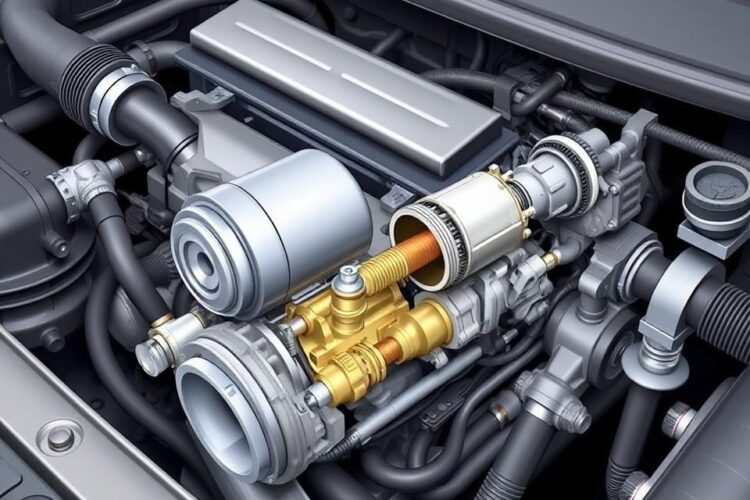The egr exhaust gas return valve is key in your car’s engine. It sends some exhaust gases back into the engine’s intake system. This is called exhaust gas recirculation.
It helps cut down on harmful emissions and makes your car run better. The egr valve is very important for keeping your car’s emissions low and running smoothly.
The egr valve is important for reducing harmful emissions. These emissions can harm the air we breathe and our health. Knowing how the egr valve works helps car owners keep it in good shape.
Key Takeaways
- The egr exhaust gas return valve is a critical component in reducing nitrogen oxide emissions.
- Exhaust gas recirculation helps improve fuel efficiency and optimize engine performance.
- The egr valve function is essential in reducing harmful emissions and improving overall vehicle performance.
- Regular maintenance of the egr valve is necessary to ensure it operates efficiently.
- Vehicle owners can face fines and MOT failures if their egr system is not operational.
- The egr valve has two main settings: open and closed, with the ability to be partially opened or closed based on vehicle speed.
What is an EGR Exhaust Gas Return Valve?
The egr exhaust gas return valve is key in the exhaust gas recirculation system. It helps cut down nitrogen oxide emissions and boosts fuel efficiency. It works by sending some exhaust gases back into the engine’s intake system.
This action is vital for meeting strict emissions rules. The EGR system has parts like the EGR valve, EGR cooler, and EGR sensor. Keeping these parts clean is important to avoid egr valve problems like black smoke and higher fuel use.
Basic Function and Purpose
The EGR valve can be in two states: open or closed. It can also be partially open or closed based on the engine’s needs. If it’s not working right, you might need to replace it to keep your engine running well.
Components of an EGR System
The EGR system has:
- EGR valve
- EGR cooler
- EGR sensor
Types of EGR Valves
There are many EGR valves, like diesel high-pressure, diesel low-pressure, and gasoline types. Each is made for different engines and conditions. Keeping them well-maintained is key to avoiding egr valve problems and keeping your engine in top shape.
| EGR Valve Type | Description |
| Diesel High-Pressure | Designed for high-pressure diesel engines |
| Diesel Low-Pressure | Designed for low-pressure diesel engines |
| Gasoline | Designed for gasoline engines |
The Role of EGR Valves in Engine Performance
The egr valve plays a key role in keeping engines running well. It helps control emissions and saves fuel. By sending exhaust gases back into the engine, it lowers the combustion temperature. This cuts down on harmful nitrogen oxides.
A good egr valve keeps the engine cool and efficient. It stays closed when the engine is idle or under low load. But it opens up when the engine works harder to reduce harmful emissions. This helps heavy-duty diesel trucks meet environmental rules by cutting NOx emissions by up to 50%.
- Reduced nitrogen oxide emissions
- Improved fuel efficiency
- Optimized engine performance
If the egr valve goes wrong, it can cause problems. Fuel efficiency drops, and the engine might knock. Emissions go up too. So, it’s important to keep the egr system in good shape to avoid these issues.
How the EGR System Affects Emissions Control
The EGR system is key in cutting down nitrogen oxide emissions. These emissions are a big part of air pollution. It does this by sending some exhaust gases back into the engine. This lowers the combustion temperature, which in turn cuts down nitrogen oxide production.
This is vital for emission control, as cars with EGR valves are made to follow emissions rules. This means they emit less nitrogen oxide because they recirculate exhaust gases.
Signs of a bad EGR valve include more fuel use. This means the car might be putting out more emissions than it should. This could lead to egr valve problems and the need for egr valve replacement.
The EGR system’s role in emissions control is big. It’s important for the car to run right and not use too much fuel. It also helps the car meet emissions rules. A working EGR system is key to avoiding egr valve problems and the need for egr valve replacement.
In short, the EGR system is a vital part of a car’s emission control system. It’s essential for cutting down nitrogen oxide emissions and following emissions rules. Knowing how the EGR system works helps car owners keep their car’s EGR system in good shape. This ensures the car runs well and doesn’t have egr valve problems.
| EGR System Component | Function |
|---|---|
| EGR Valve | Recirculates exhaust gases back into the engine’s intake system |
| Mass Airflow Sensor | Measures the amount of air entering the engine |
| Temperature Sensor | Monitors the temperature of the exhaust gases |
Common Signs of EGR Valve Problems
Finding egr valve problems can be tricky. Yet, there are clear signs that show when something’s wrong. These signs include knocking noises, rough idling, and more fuel used than usual. If the EGR valve gets stuck, it can mess up your engine’s performance, increase emissions, and cut down on fuel efficiency.
Symptoms of a bad EGR valve include:
- Rough idle
- Poor performance
- Increased fuel consumption
- Stalling
These signs happen when the valve stays open or closed too long. This makes it hard to figure out what’s wrong.
At times, you might need to replace the egr valve to fix the issue. It’s key to get a pro to check and replace it if you think there’s a problem. Keeping the EGR valve clean and checked regularly can stop issues and make sure it works right.
| Symptom | Description |
| Rough idle | Engine idles roughly, potentially causing vibrations |
| Poor performance | Engine performance is reduced, leading to decreased fuel efficiency |
| Increased fuel consumption | Engine consumes more fuel than usual, leading to increased emissions |
Knowing the common signs of EGR valve problems helps you fix them early. Regular checks and maintenance keep the EGR valve working well. This reduces the chance of egr valve problems and keeps your engine healthy.
Maintaining Your Car’s EGR Valve System
Keeping your egr valve system in good shape is key. This means checking it often, egr valve cleaning, and replacing parts when needed. It’s smart to check the EGR valve every 50,000 miles, or as the maker suggests.
To keep your car’s EGR valve system running well, here’s what to do:
- Look for any damage or wear on the EGR valve.
- Regularly clean the EGR valve and other parts to avoid blockages.
- Swap out the EGR valve if it’s broken or not working right.
Keeping the egr valve clean helps it work better. If you’re not sure how to care for your EGR valve, get help from a skilled mechanic. They can replace the EGR valve if it’s needed and teach you how to keep it in top shape.
| Maintenance Task | Frequency | Importance |
|---|---|---|
| Inspect EGR valve | Every 50,000 miles | High |
| Clean EGR valve | Every 30,000 miles | Medium |
| Replace EGR valve | As needed | High |
EGR Valve Replacement: What to Expect
Understanding egr valve replacement is key. The cost can vary from $150 to $650. This depends on your car’s make and model, plus labor costs. In places like London, prices can go up to $417.
Installing an EGR valve is complex. It needs special tools and a skilled mechanic. The cost can also depend on the car’s brand. For example, Audi’s average cost is $539.
- Average replacement time: 1 to 3 hours
- Average cost: $265
- Price range: $150 to $650
Regular maintenance, like using SeaFoam, can help avoid EGR problems. Knowing the costs and process helps you make better choices for your car.
Digital vs. Mechanical EGR Systems: Understanding the Difference
When we talk about egr system comparison, we see two main types. Digital egr systems use electronics for better control and performance. Mechanical egr systems, on the other hand, use vacuum and mechanical parts. They can be less precise and more likely to break.
Digital egr systems are great because they can watch and fix problems on their own. This means less time waiting and more work done. Mechanical systems need more hands-on work and can take longer to fix.
| System Type | Control Method | Precision | Diagnostic Capabilities |
| Digital EGR Systems | Electronic | High | Real-time monitoring and self-diagnostic |
| Mechanical EGR Systems | Vacuum-operated | Lower | Manual intervention required |
In short, digital egr systems are better for performance and work. When looking at egr system comparison, think about the good points of digital systems. These include their accuracy and ability to find and fix problems. But, also remember the downsides of mechanical systems.
Impact of EGR Problems on Vehicle Performance
EGR valve problems can really hurt how well your car runs. They can make your car use more fuel and lose power. A bad EGR valve messes up the air-to-fuel mix in the engine. This can make your car idle roughly and even cause it to misfire.
Some key effects of EGR valve problems on vehicle performance include:
- Reduced fuel economy: A malfunctioning EGR valve can lead to abnormal fuel consumption, impacting fuel efficiency negatively.
- Decreased engine power: EGR valve problems can cause a reduction in engine performance, resulting in rough idling and reduced power.
- Long-term engine health: Failure to address EGR valve issues can escalate vehicle maintenance costs and may increase the vehicle’s environmental impact due to higher emissions.
Keeping the EGR system clean can help. It stops clogs and helps air and fuel mix better. Fixing EGR valve problems fast is key to avoiding engine damage.
Knowing how EGR problems affect your car helps you keep it running well. It’s all about taking care of your engine and keeping your car in top shape.
| EGR Valve Problem | Effect on Vehicle Performance |
| Malfunctioning EGR valve | Reduced fuel economy, decreased engine power |
| Clogged EGR passages | Rough idling, reduced engine performance |
| Failed EGR cooler | Engine overheating, increased repair costs |
Looking Ahead: The Future of EGR Technology in Modern Vehicles
The car world is always changing, and the Exhaust Gas Recirculation (EGR) valve is key. It helps make cars cleaner, more efficient, and powerful. The EGR tech market is set to grow fast, reaching USD 10.09 billion by 2030.
The focus on EGR technology in modern vehicles will be on better emission control. New materials, designs, and electronic controls are being worked on. These will make EGR valves more efficient and last longer.
Even as electric cars become more popular, EGR systems will stay important. They are essential in both traditional and hybrid cars. The push for cleaner cars means EGR valves will keep being a big part of the car world.

